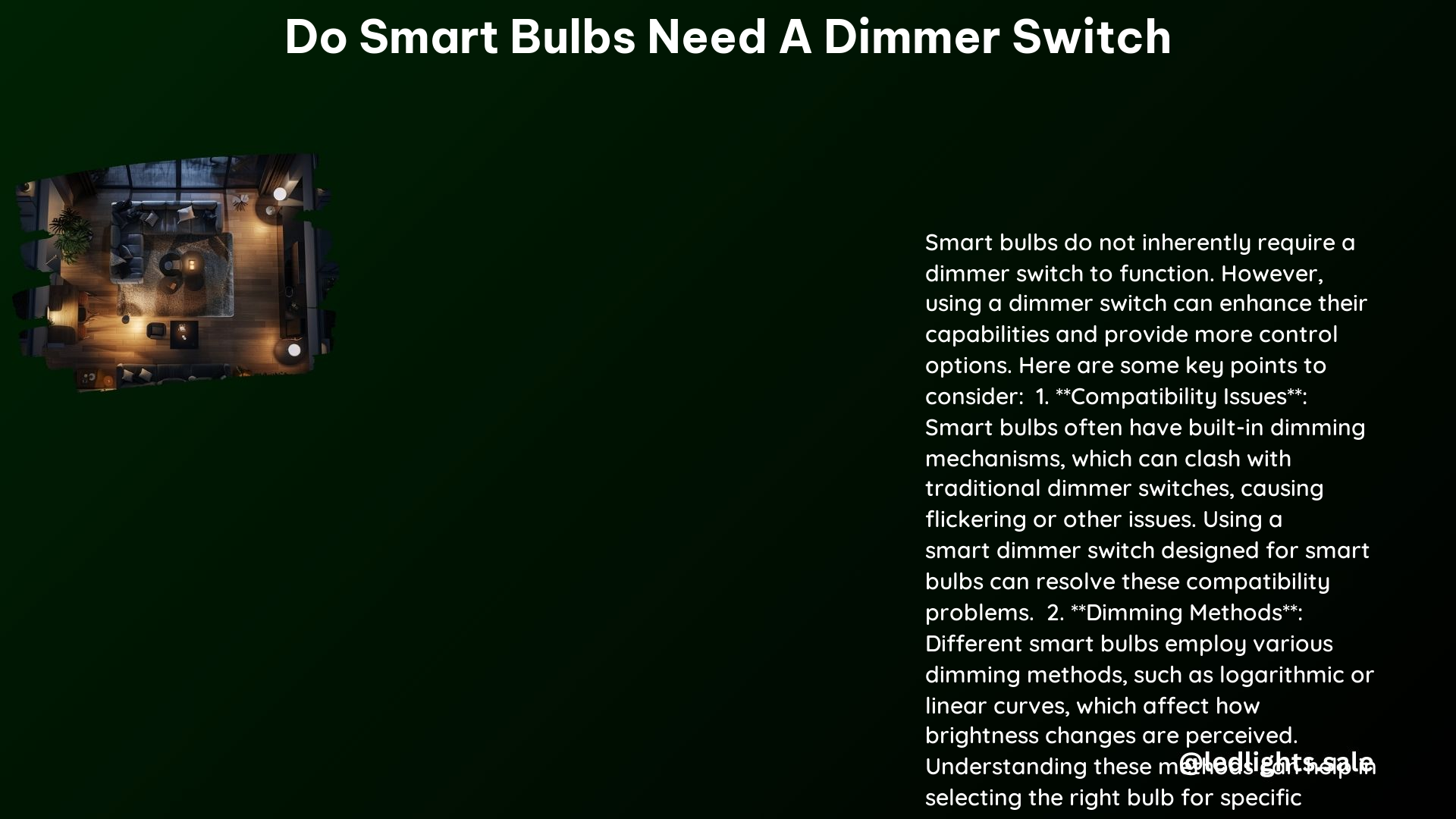Smart bulbs have revolutionized the way we illuminate our homes, offering advanced features like remote control, color changing, and energy-efficient operation. However, the question of whether smart bulbs require a dimmer switch is a common one among homeowners. In this comprehensive guide, we’ll dive deep into the technical aspects, compatibility considerations, and best practices for using smart bulbs with or without a dimmer switch.
Compatibility Issues with Dimmer Switches
One of the primary concerns when using smart bulbs with dimmer switches is compatibility. Traditional dimmer switches work by reducing the amount of power delivered to the bulb, which can cause issues with smart bulbs. Smart bulbs often have their own built-in dimming mechanisms that can clash with the dimmer switch, leading to flickering, inconsistent brightness, or even complete failure of the bulb.
The compatibility issues can be particularly problematic with older dimmer switches, which may not be designed to work seamlessly with the advanced technology found in modern smart bulbs. Newer smart bulbs, on the other hand, may be more compatible with certain types of dimmer switches, but it’s essential to check the manufacturer’s recommendations to ensure a smooth and reliable operation.
Smart Dimmer Switches: The Ideal Solution

To address the compatibility issues, manufacturers have developed specialized smart dimmer switches designed to work seamlessly with smart bulbs. These smart dimmer switches are engineered to provide a consistent and reliable dimming experience without causing any conflicts with the smart bulb’s internal dimming mechanisms.
Smart dimmer switches often come with additional features, such as the ability to be controlled through mobile apps or voice assistants. This integration ensures that the bulb remains powered even when the switch is turned off, allowing for remote control and advanced features like color changing and scheduling.
Using Smart Bulbs with Regular Switches
While smart bulbs can be used with regular, non-smart switches, it’s important to understand the limitations of this setup. When the switch is turned off, the smart bulb will lose power and be unable to receive any remote commands or access its advanced features. This means that the bulb’s color-changing capabilities, dimming functions, and other smart features will only work when the switch is in the “on” position.
To ensure the full functionality of smart bulbs, it’s recommended to use them with smart switches or smart dimmer switches specifically designed for this purpose. This way, you can take advantage of the bulb’s advanced features while maintaining control over the lighting through your preferred smart home platform or voice assistant.
Best Practices for Smart Bulb and Dimmer Switch Integration
To ensure a seamless and reliable experience when using smart bulbs with dimmer switches, consider the following best practices:
-
Compatibility Check: Before purchasing a smart bulb or a dimmer switch, carefully check the manufacturer’s recommendations and compatibility information. This will help you avoid any potential issues and ensure that the components work together as intended.
-
Use Smart Dimmer Switches: As mentioned earlier, smart dimmer switches designed for smart bulbs are the ideal solution. These switches are engineered to provide a smooth dimming experience without causing any conflicts with the bulb’s internal dimming mechanisms.
-
Maintain Power to the Bulb: If using a regular switch, make sure to keep the switch in the “on” position at all times. This will ensure that the smart bulb receives a constant power supply, allowing you to take advantage of its remote control and advanced features.
-
Understand Dimming Curves: Some smart bulbs, like those from Philips Hue and Lifx, use logarithmic dimming curves to account for the way the human eye perceives brightness changes. This means that the dimming may not be linear, and it’s essential to understand the specific dimming characteristics of your smart bulbs to achieve the desired lighting effects.
-
Regularly Update Firmware: Manufacturers often release firmware updates for smart bulbs and switches to address compatibility issues and improve performance. Regularly checking for and installing these updates can help ensure that your smart home setup continues to function optimally.
Technical Specifications and Considerations
Smart bulbs typically require a constant power supply to function correctly, as they rely on a continuous connection to the power source to receive and execute remote commands. Using a dimmer switch that reduces the power supply can affect the performance and reliability of smart bulbs, potentially leading to issues like flickering, inconsistent brightness, or even complete failure.
Additionally, some smart bulbs, like those from Philips Hue and Lifx, use logarithmic dimming curves to account for the way the human eye perceives brightness changes. This means that the dimming may not be linear, and the perceived brightness may not match the actual power reduction. Understanding these technical specifications can help you achieve the desired lighting effects and avoid any unexpected behavior.
Conclusion
In summary, while smart bulbs do not inherently require a dimmer switch to function, using a dimmer switch with smart bulbs can lead to compatibility issues if not done correctly. To ensure a seamless and reliable experience, it’s recommended to use smart bulbs with smart dimmer switches designed specifically for this purpose. If using a regular switch, make sure to keep it in the “on” position to allow for remote control and advanced features.
By understanding the technical specifications, compatibility considerations, and best practices outlined in this guide, you can confidently integrate smart bulbs into your home and enjoy the full range of their advanced lighting capabilities.
References:
1. https://community.hubitat.com/t/best-practice-for-smart-bulbs-connected-to-smart-switches-and-dimmer/115584
2. https://www.nytimes.com/wirecutter/blog/using-smart-switches-for-smart-lights/
3. https://www.cnet.com/home/kitchen-and-household/things-to-know-about-smart-lights-before-you-buy-a-boatload-of-them/
4. https://www.reddit.com/r/homeautomation/comments/15gpt1r/smart_bulbs_with_dimming_switches/
5. https://www.gelighting.com/inform/smart-bulbs-work-with-switches-regular-smart
